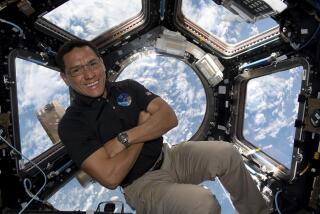Concern Rises for Voyager Pilots’ Health : Plane Passes Halfway Mark, Breaks the Distance Record
- Share via
MOJAVE — Voyager pilots Dick Rutan and Jeana Yeager passed the halfway mark and headed for home Thursday, having already flown farther without refueling than anyone else has ever done.
“At this time, we are very optimistic on making the whole mission,” Burt Rutan, the pilot’s brother and designer of the Voyager, said Thursday.
It will be midday today before the crew will have the treacherous storms and towering mountains of Africa behind them, completing what flight officials regard as one of the most dangerous legs of the globe-circling mission.
Early Thursday evening, California time, the Voyager passed over the east coast of Africa at about dawn there--just as the sun begins to heat the atmosphere and stir up stormy weather. Meteorologists had hoped to make more of the crossing at night.
It will take 18 to 21 hours for the Voyager to reach the west coast of Africa. Earlier in the day, the plane cruised across the Indian Ocean at about 105 m.p.h. at around 8,000 feet altitude. But some of the mountains in its path across central Africa tower more than 13,000 feet, according to meteorologist Rich Wagner, requiring the plane to climb as high as 16,000 feet to get over both mountains and turbulent weather.
“They will be over Africa during daylight hours, and there is a very high potential for thunderstorms,” Wagner said, noting that the crew will not fly over any areas that are politically sensitive. That means it will not always be possible to follow the best course from the standpoint of weather.
He said any celebrations now would be premature.
“The meteorologists are going to pop the cork on the champagne when we get past the west coast of Africa,” Wagner said.
Flight spokesman Peter Riva said the pilots “were quite adamant that the 32 hours of bad weather (already behind them) for them was an ordeal, a trial by fire. . . . Dick said they have bumps, bruises.”
Somewhere over Africa, and for the first time since Hawaii, a chase plane was expected to meet up with Voyager, and flight officials planned to use that rendezvous to try to learn a little more about how much fuel remains aboard the aircraft.
Burt Rutan, the Voyager’s designer, had said on Wednesday that the plane was burning so much fuel dodging storms that it might not have enough left to make it back to Edwards Air Force Base.
But by Thursday, he was reasonably convinced that the aircraft had more fuel remaining than flight logs indicated, even though there is no way to precisely measure it. The 17 fuel tanks aboard the Voyager do not have gauges.
Earlier, flight logs kept by the crew had indicated that the plane, which had to use both engines longer than planned, was using far more fuel than expected.
Burt Rutan said Thursday, however, that the climb and cruise data radioed back by the crew indicate the Voyager is heavier--and thus carrying more fuel--than it would be if the logs were correct. That led him to conclude that the fuel shortage is really just an “accounting error.”
One way to be sure would be to weigh the Voyager, and in a sense that is what the crew will do somewhere over Africa.
While accompanied by the chase plane, which can clock the Voyager’s speed precisely, Rutan will deliberately put the aircraft into an aerodynamic stall, in which the pilot raises the nose of the aircraft and slows the plane to the point that its wings no longer produce lift and the plane vibrates.
The speed at which it stalls is determined largely by the plane’s weight, which is dependent on the amount of fuel remaining aboard. Thus the stall speed will give flight officials another reading on how much fuel remains.
No Ocean Ditch
Burt Rutan emphasized Thursday that there is no danger that the Voyager will suddenly run out of fuel and have to ditch in the ocean. The plane’s final tank is located alongside the pilot’s seat. There is enough fuel in that tank for the Voyager to fly several thousand miles.
It was at midday Thursday, while crossing the Indian Ocean off the east coast of Africa, that the Voyager passed the 12,533-mile mark, unofficially topping the distance record set in 1962 by an Air Force B-52. In order to claim the record, however, the mileage will have to be certified by the Federation Aeronautique Internationale of Paris, a formality that will come later.
The Voyager is expected to return to Edwards on the day before Christmas, possibly at dawn.
More to Read
Sign up for Essential California
The most important California stories and recommendations in your inbox every morning.
You may occasionally receive promotional content from the Los Angeles Times.













